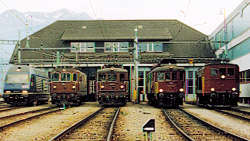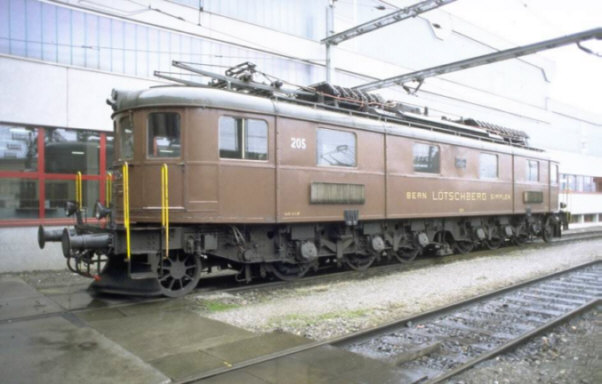BLS the line with electric giants.

Five generations of electrical power on BLS.
Photo.BLS
The BLS has in the beginning hosted some of the most powerful engines during its history from the beginning to present. Here is a short presentation of some of the remarkable classes of different generations of motive of power.
Ae 6/8

Photo by: John M. Lovda,
jlovda@attglobal.net
The magnificent Ae6/8 and their twins of Be6/8 classes were the most powerful engines in the world when the first batch, 201-204 were delivered in 1926-1931. The engines rode on articulated frames, consisting of two frames of three drivers and pilot wheel, short coupled under the common upper structure with cabs and machine room for the electrical apparatures. These engines had orginally box liked cabs, that were rebuilt in to roundshaped cabs when the engines 205-208 were delivered. They were quite long for electrics, measureing 20.26 meter from the endbuffers. And they had power to match their apparance. The six axles of driver could pull a 800 ton freight over a 1.55 % grade and a 510 ton freight over the 2.7% grade to Kandersteg. The engines had a maximium speed of 75 km/h and weighted 141.6 tons and delivered 4 500hp. The engines were coproduced by SAAS and Breda.
In 1937 BLS decided to add more powerful engines to its roster. A need of power for the express trains able to run at speeds of 90 km/h caused that a second batch 205-208 was ordered. The engines power was increased to 5113 hp and the new engines were classified as Ae6/8.s. When the engine 205 was delivered, BLS decided to upgrade 201-204 to match performance and looks of the new engines. The new roundshaped cabs offered a novelty for the engineer, a seat. Engine 205 was exebitioned along SBB.s 11 100 hp Ae8/14 in Zürich in 1939.
The ever increase of demand of more power and additonal speed led in to further modification during the sixties. After rebuilt, engines could run in speed of 100 km/h and produce 6000 hp.
The engines sported a large lettering that were replaced by the now common BLS on their flanks. Their looks was altered when new transformers were installed, the middle pair of side windows were replaced by a pair of large lowers on one side, the windows and louvers on the other side were left intact. A need of more braking the orginal dynamic brakes improved, and the additional apparatures of these placed on the roofs and one of the pantographs were removed.
The engines became landmarks of swiss railroading along the SBB.s "Crocodiles" and served through the 80.es and three engines are prserved. Engine 205 received the orginal lettering and is currently used as power for excursiontrains on BLS.